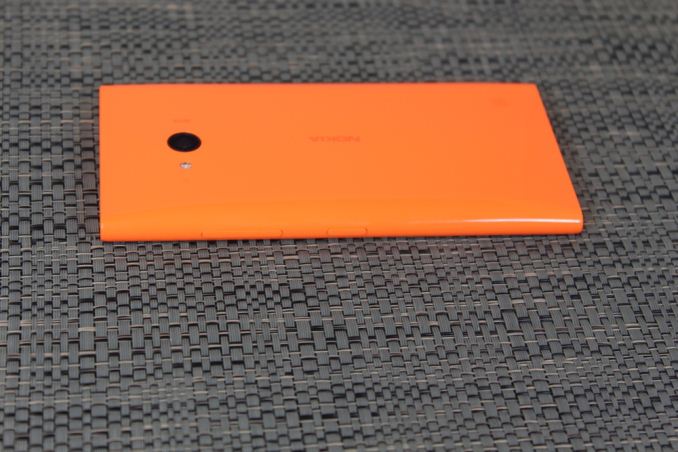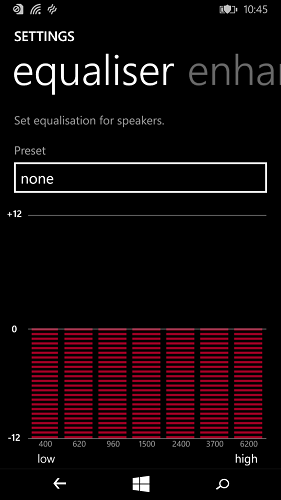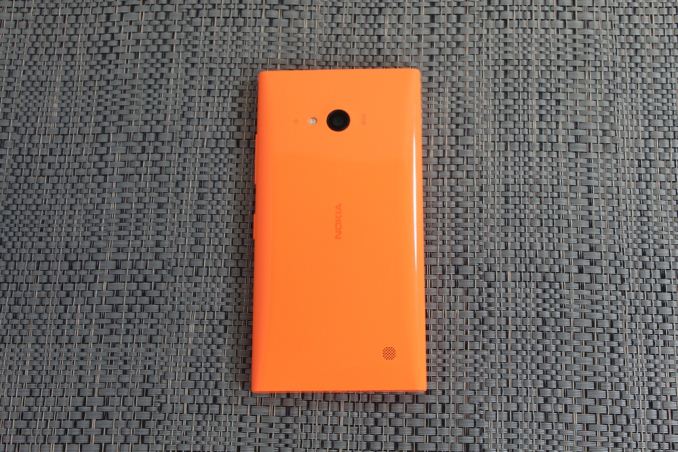Nokia Lumia 735 Review
by Brett Howse on February 3, 2015 6:00 AM EST- Posted in
- Smartphones
- Microsoft
- Nokia
- Lumia
Design
Mainstream smartphones seem to have settled in on a five inch display being the average, with a few just a bit larger and a few just a bit smaller. The Lumia 735, with a 4.7 inch display, is a great size for people who do not want the largest phone they can get. Although the Lumia 735 is not created with ultra-high end materials, it carries the traditional Lumia design forward with a fully polycarbonate body finished with a glossy shell.
The 735 really feels like a successor to the original Lumia, the Lumia 800. Although larger, it features the same shape, with rounded sides and a squared off top and bottom. The curve continues into the display glass, with the sides of the glass featuring the same radius as the body, and it creates a great look and feel to the phone. The curved sides also compliment the smaller body size (as compared to the Lumia 830 and other five inch smartphones) and make it very comfortable to hold on to.
The top of the phone features the 3.5 mm headset jack, and the bottom of the phone has the micro USB connector for attaching to a PC or for charging. As with all Lumias, the left side has no buttons, and the right side features the power and volume rocker. Nokia has made a distinction with this year’s lineup of phones that any device without a PureView camera will not get a dedicated camera button, so the Lumia 735 lacks this. Windows Phone 8.1 does not have an easy way to access the camera through software other than to add the camera to the quick launch buttons in the Action Center, so this ends up being more of a burden than you would think. Also, unlike on the Lumia 830 and higher devices, the physical buttons are plastic, and are the same material as the body. They have great feedback though.
Speaking of buttons, the Lumia 735 follows in the footsteps of other devices like the Lumia 630 in that it lacks capacitive buttons for back, home, and search. The Lumia 630 compensated for this with on-screen buttons which had a dedicated number of pixels set aside for this task, but the Lumia 735 lacks this dedicated space on the display. The buttons will auto-hide when something like a photo is displayed, and can be accessed by swiping up on the display similar to modern HTC devices. I found this to be a less than perfect solution, and would prefer actual capacitive keys over losing display real estate to the on-screen versions but it does represent a dichotomy in the way of doing these - there will be users who prefer one over the other.
On-Screen Buttons appear in Screenshots since there is not a dedicated amount of screen for them
The back of the phone has a fairly minimalist look, with the Nokia logo subtly located in the center. The 6.7 MP camera sensor is in the center as well, near the top of the phone, and is flanked by the LED flash and one of the microphone grilles. There is also a faint Zeiss logo to let you know that this camera carries Carl Zeiss optics. The bottom of the back features the speaker grille. The back is also removable to get access to the micro SD slot as well as the battery. Even though the back is removable, there is no creaking or movement when installed. If you did not know the back was removable, you would think this is a unibody phone.
The Lumia 735 does not break new ground on industrial design or material choices, but it does continue with the traditional Lumia feel and look. The color choices are vibrant, and the orange that I received as a review unit looks great with the glossy finish. The phone fits well in the hand, and the curved glass on the front fits well with the design and provides a smooth transition to the body of the phone. Considering the back is removable, the smooth transition shows attention to detail.













64 Comments
View All Comments
gijames1225 - Tuesday, February 3, 2015 - link
What's the rationale for when to include and when not to include iPhones in the comparisons? No iPhone was compared in the battery life charts, but it's there in a lot of the other charts.melgross - Tuesday, February 3, 2015 - link
Particularly as it was said that the testing app is now compatable across systems.Brett Howse - Tuesday, February 3, 2015 - link
We pull our data from our online database, and the iPhone would not be included if that particular test was not run on it. GFXBench just updated to this version recently on iOS (by recently I mean since our initial review)gijames1225 - Tuesday, February 3, 2015 - link
Cool, thanks for the explanation.hlovatt - Tuesday, February 3, 2015 - link
There was some comparison against iPhone5c, but inconsistent and missing for performance. So the review was a bit disappointing overall :(Brett Howse - Tuesday, February 3, 2015 - link
Our benchmarks evolve over time, and as new versions come out, we migrate towards them. The 5c was reviewed a while ago, so it would not have been run on benchmarks that came out after its launch, but price wise is still similar to the 735 so I included it where I could. If you want to compare the 735 to any other iPhones, I mentioned in the article that we have a great online tool for that called Bench which you can find a link to at the top of our main page.hlovatt - Tuesday, February 3, 2015 - link
Thanks for your reply. Pity that the newer benchmarks are not available for 5C. I guess that provided that the benchmarks don't continually change this won't be a common problem. Pity in this case, but thanks again for the reply.bullzz - Tuesday, February 3, 2015 - link
@Brett - Great review. in some CPU and GPU benchmarks why does 735 perform 10-30% slower than Moto G. I thought they were using the same socI don't know why anyone would buy this or 830 over Moto G LTE. better performance, better display, better OS. Only upside is battery life but I think MotoG has much better value to it
Daniel Egger - Tuesday, February 3, 2015 - link
Because people typically buy phones for the full package rather than just plain hardware specs? Otherwise neither Motorola nor Microsoft nor Apple would sell any phones...Brett Howse - Tuesday, February 3, 2015 - link
Yes, they are the same SoC. Snapdragon 400 in both. In the web browser tests, Internet Explorer is much slower than Chrome. IE is being replaced though, and the new replacement is already much faster, so on Windows 10, this should be less of an issue.As for the GPU benchmarks, my suspicion is that the video drivers for Adreno are more tuned for Android than they are for Windows Phone with DirectX.